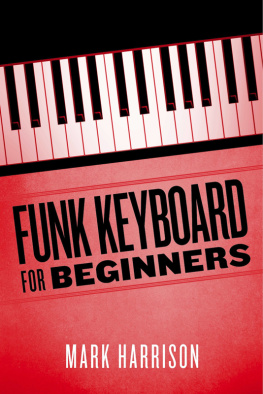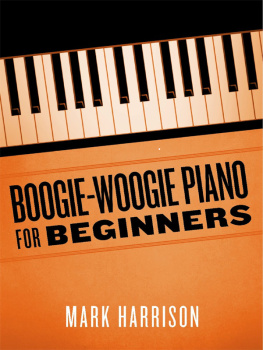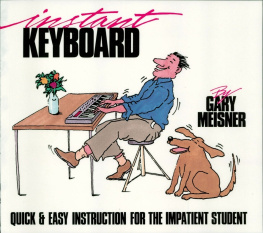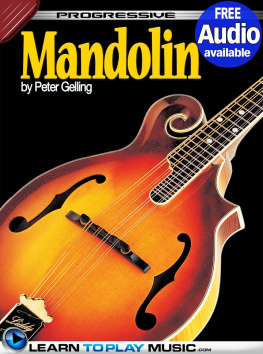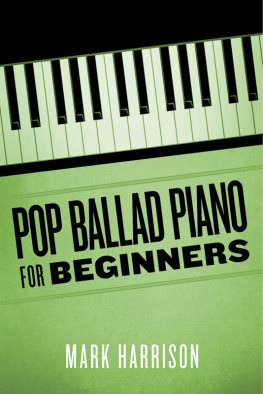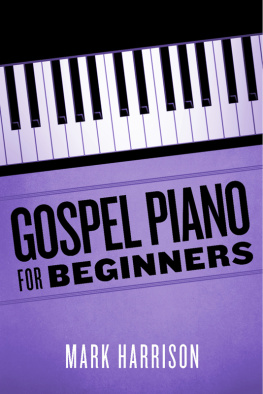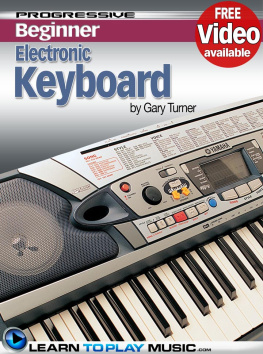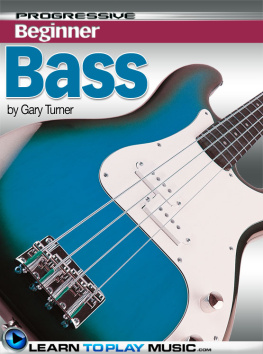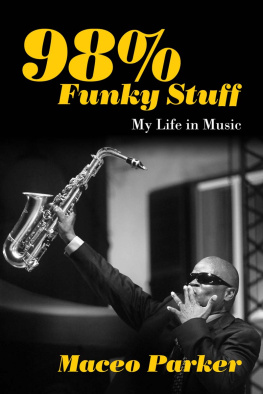

Published by: Harrison Music Education Systems, P.O. Box 5068, West Hills, CA 91308, USA
Publication date: 07/01/12
Copyright: 2012 Mark Harrison
ISBN Number: 9781623095062
For information on our music education books and CDs, downloadable products and packages, and private on-line lessons, please visit our website: www.harrisonmusic.com
Welcome to Funk Keyboard For Beginners. This book will start you on the road to playing authentic funk keyboard, even if you are a complete beginner. Youll get started right away by learning some essential funky grooves to use on your first (or next) R&B/funk keyboard gig!
Please email us at books@harrisonmusic.com with Funk Keyboard For Beginners in the subject, to receive your FREE mp3 audio recordings of all the music examples in this book! Most of the audio recordings feature a rhythm section on the left channel, and the piano on the right channel. To play along with the band, turn down the right channel to eliminate the recorded piano. To hear the piano part for reference, turn down the left channel to eliminate the rhythm section.
Along with your free mp3s, you will also receive free pdf versions of all the music notation examples. So if your e-reader does not display the notation examples clearly enough, you can use the pdf versions as a convenient alternative.
Most funk grooves are based on either eighth-note or sixteenth-note rhythmic subdivisions. An eighth note divides the beat in half, and the sixteenth note divides the beat into four quarters. Well get started here with some the easier eighth-note rhythms. Lets jump right into our first eighth-note funk comping pattern using right hand triads:
Example 1

A quick theory note: the chord symbol above the staff is an A minor 7th chord, which is spelled A C E G. The root of the chord (A) is played by the left hand, and the upper part (C E G) is played by the right hand. These upper notes C E G also form a C major triad, which we could say has been built from the 3rd of the overall A minor 7th chord.
Be sure to check out the mp3 audio track for this example (especially if your note reading is at a beginning level!) On the track we are using a classic electric piano sound, which is typical for this type of funk groove. Also the fingering numbers are shown on the staff: in the right hand, the thumb, middle and pinky fingers are playing the C, E and G respectively, and in the left hand the pinky is playing the A, with the thumb adding the A an octave higher in the last two measures.
The eighth-note rhythmic counting (1 & 2 & 3 & 4 &) is shown above the staff. This is how eighth notes are counted, with the 1, 2, 3 and 4 falling on the downbeats, and the &s in between falling on the upbeats. Count along to the mp3 audio track accompanying this example, to get comfortable with this rhythmic concept.
The key to successful funk keyboard grooves is the use of rhythmic anticipations i.e. landing ahead of the beat. In this example, the right hand C major triad (upper part of the overall A minor 7th chord) lands on the & of 2, which is an anticipation of beat 3. As you play this example, focus on getting these right hand rhythms steady and consistent.
In the last two measures, the left hand adds the higher root note A on beat 4, adding some further momentum to the groove. Again, check out the mp3 recording of this track to hear what these rhythms sound like! On to our next eighth note triad pattern:
Example 2

Here the voicing technique used for the A minor 7th chord is the same as in Example 1. Now though the rhythm has been varied, with the second C major triad in each measure falling on the & of 3, which anticipates beat 4. Also in the last two measures for the left hand, the higher root note A is now on the & of 4, functioning as an eighth note pickup into beat 1 of the following measure. (Refer back to Example 1 for the eighth-note rhythmic counting as needed). Our next eighth note triad pattern uses a similar voicing technique on a D minor 7th chord:
Example 3

Another quick theory note: the chord symbol above the staff is a D minor 7th chord, which is spelled D F A C. The root of the chord (D) is played by the left hand, and the upper part (F A C) is played by the right hand. These upper notes F A C also form an F major triad, which we could say has been built from the 3rd of the overall D minor 7th chord.
Also in this example, the upper F major triad is in second inversion (C F A from bottom to top), rather than in root position. The use of inversions allows us to move smoothly between successive chords in a progression more about this later on.
The right hand rhythm now combines the anticipations used in Examples 1 and 2: the upper triad is landing on the & of 2 and the & of 3, anticipating beats 3 and 4 respectively. In the last two measures the left hand plays a busier octave pattern, using the rhythmic spaces within the right hand part. As you play this example, be aware of this rhythmic conversation occurring between the hands at this point - this is very typical of funk keyboard styles.
Our next eighth note triad pattern uses a similar voicing technique on an E minor 7th chord:
Example 4

Another quick theory note: the chord symbol above the staff is an E minor 7th chord, which is spelled E G B D. The root of the chord (E) is played by the left hand, and the upper part (G B D) is played by the right hand. These upper notes G B D also form a G major triad, which we could say has been built from the 3rd of the overall E minor 7th chord. Also in this example, the upper G major triad is in first inversion (B D G from bottom to top).
In this example, the upper G major triad is landing on the & of 1 and the & of 2, anticipating beats 2 and 3 respectively. In the last two measures the left hand plays an octave root-note pattern during beat 4.
Next were going to develop these funk comping or accompaniment techniques, over a funk/blues chord progression. A simple funk/blues progression can be created using I, IV and V chords within a minor key (this is equivalent to building chords from the first, fourth and fifth degrees of a natural minor scale). First well need to review a little bit of theory to see where these chords come from:
Example 5

In this example, the empty noteheads spell out an A natural minor scale (A-B-C-D-E-F-G-A from left to right). Above the first, fourth and fifth degrees (A, D and E) we have built A minor 7th, D minor 7th and E minor 7th chords respectively. These chords are all found within the A natural minor scale, and within the key of A minor.
These chords have all been used in the preceding Examples 1 4: review the earlier text for the spelling of each chord as needed. Next well arrange these chords into a twelve-bar minor funk/blues progression, using the rhythmic comping pattern from Example 1:
Next page
